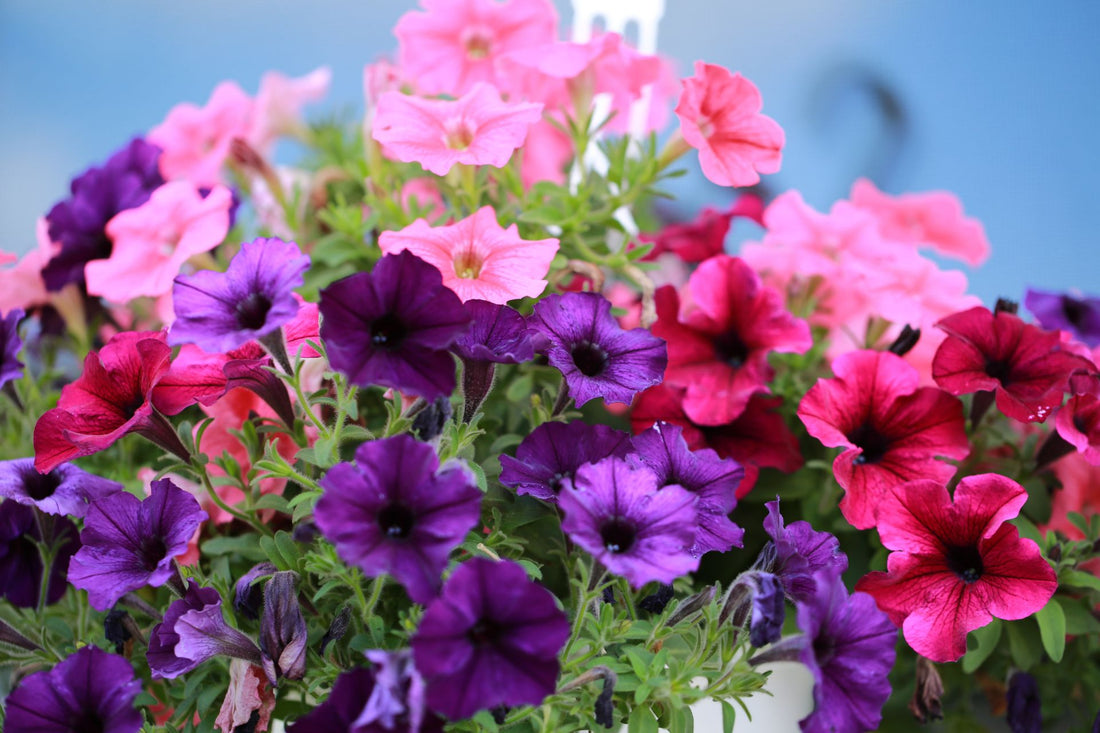When it comes to planting and growing flowers, we’re all spoiled for choice. But there are certain kinds that thrive - and look - better than the others, especially in railing and balcony planters.
1. Petunias
Petunias are a classic choice for deck railing planters, and it's easy to see why. These vibrant, trumpet-shaped flowers come in a wide array of colors, from bold purples and reds to soft pinks and whites. They bloom prolifically throughout the summer, creating a stunning cascade of color that's sure to catch the eye of anyone passing by.
Petunias are well-suited for deck railing planters for several reasons:
- They're low-maintenance: Petunias are relatively easy to care for, making them a great choice for busy homeowners or novice gardeners.
- They thrive in sunny locations: Deck railing planters often receive plenty of direct sunlight, which is perfect for sun-loving petunias.
-
They're versatile: Whether you prefer a single color or a mix of hues, petunias can be arranged to create a variety of stunning displays.
To ensure your petunias thrive in your deck railing planters, follow these care tips:
- Water regularly, but avoid overwatering as this can lead to root rot. Allow the soil to dry slightly between waterings.
- Deadhead spent blooms to encourage continuous flowering throughout the season.
- Fertilize every 2-3 weeks with a balanced, water-soluble fertilizer to promote healthy growth and abundant blooms.
2. Geraniums
Geraniums are another fantastic option for deck railing planters, offering a classic charm and a variety of colors to choose from. These hardy flowers come in a range of types, including zonal geraniums with their distinct leaf markings, ivy geraniums that trail beautifully over the sides of planters, and scented geraniums that add a delightful fragrance to your outdoor space.
Geraniums offer several benefits when used in deck railing planters:
- They're drought-tolerant: Once established, geraniums can withstand periods of dryness, making them a great choice for those who occasionally forget to water.
- They're long-blooming: With proper care, geraniums can bloom from spring through fall, providing months of vibrant color.
- They're pest-resistant: Geraniums are naturally pest-resistant, which means you can enjoy their beauty without worrying about pesky insects.
To keep your geraniums looking their best in your deck railing planters, follow these simple care tips:
- Provide plenty of sunlight: Geraniums thrive in full sun, so choose a spot that receives at least 6 hours of direct sunlight daily.
- Water wisely: Allow the soil to dry slightly between waterings, and avoid getting water on the foliage to prevent leaf spot or fungal growth.
- Deadhead regularly: Remove spent blooms to encourage continuous flowering and maintain a tidy appearance.
3. Calibrachoa (Million Bells)
If you're looking for a flower that packs a punch in a small package, look no further than calibrachoa, also known as "Million Bells." These tiny, bell-shaped blooms come in a kaleidoscope of colors, from vibrant yellows and oranges to soft pinks and purples. Calibrachoa plants have a trailing habit, making them perfect for cascading over the sides of your deck railing planters and creating a stunning visual effect.
Growing calibrachoa in deck railing planters offers several advantages:
- They're low-maintenance: Calibrachoa plants are self-cleaning, which means they don't require deadheading to keep blooming.
- They're heat-tolerant: These tough little flowers can withstand the heat of summer, making them a great choice for sunny deck railing planters.
- They attract pollinators: Calibrachoa blooms are a favorite among hummingbirds and butterflies, adding an extra element of interest to your outdoor space.
To ensure your calibrachoa plants thrive in your deck railing planters, keep these tips in mind:
- Provide well-draining soil: Calibrachoa plants prefer soil that drains easily to prevent root rot. Consider adding perlite or vermiculite to your potting mix to improve drainage.
- Water regularly: While calibrachoa plants are drought-tolerant once established, they perform best when watered consistently. Aim to keep the soil evenly moist but not soggy.
- Fertilize weekly: To promote healthy growth and abundant blooms, feed your calibrachoa plants with a water-soluble fertilizer once a week.
4. Lobelia
Lobelia is a charming and delicate flower that adds a touch of elegance to any deck railing planter. With its tiny, star-shaped blooms in shades of blue, purple, and white, lobelia creates a stunning trailing effect as it cascades over the edges of the planter. This low-growing plant is perfect for filling in gaps and softening the edges of your flower arrangements.
Lobelia is an excellent choice for deck railing planters for several reasons:
- It thrives in partial shade: Unlike many other flowering plants, lobelia actually prefers a bit of shelter from the harsh afternoon sun, making it ideal for planters that receive a mix of sun and shade.
- It blooms all summer long: With proper care, lobelia will continue to produce delicate flowers throughout the summer months, providing a constant source of color and interest.
- It's low-maintenance: Lobelia is relatively easy to care for, making it a great choice for those who want a beautiful planter without a lot of fuss.
To keep your lobelia looking its best, follow these simple care instructions:
- Water regularly: Lobelia prefers consistently moist soil, so be sure to water your planter whenever the top inch of soil feels dry to the touch.
- Fertilize every 2-3 weeks: To encourage healthy growth and abundant blooms, feed your lobelia with a balanced, water-soluble fertilizer every 2-3 weeks.
- Deadhead spent blooms: While not strictly necessary, removing spent flowers will help keep your plant looking tidy and encourage continued blooming.
5. Begonias
Begonias are a diverse group of plants that offer a wide range of colors, textures, and forms, making them a versatile choice for deck railing planters. From the classic wax begonias with their rounded leaves and vibrant blooms to the more exotic tuberous begonias with their ruffled flowers and angular foliage, there's a begonia variety to suit every taste and style.
Using begonias in your deck railing planters offers several benefits:
- They're shade-tolerant: Many begonia varieties thrive in partial to full shade, making them a great option for planters that don't receive a lot of direct sunlight.
- They're low-maintenance: Begonias are relatively easy to care for, as long as you provide them with well-draining soil and protect them from extreme heat and cold.
- They add visual interest: With their unique leaf shapes and textures, begonias can add depth and dimension to your planter arrangements, even when they're not in bloom.
To keep your begonias looking their best, follow these simple care guidelines:
- Water wisely: Begonias prefer evenly moist soil, but be careful not to overwater them, as this can lead to root rot. Allow the top inch of soil to dry slightly between waterings.
- Provide adequate drainage: Make sure your deck railing planters have plenty of drainage holes to prevent water from accumulating around the roots.
- Fertilize regularly: Feed your begonias with a balanced, water-soluble fertilizer every 2-3 weeks to encourage healthy growth and abundant blooms.
6. Impatiens
Impatiens are a classic choice for adding a splash of color to your deck railing planters. These cheerful flowers come in a wide range of hues, from soft pastels to bold and vibrant shades, making them a versatile option for any color scheme. With their compact growth habit and ability to bloom continuously throughout the summer, impatiens are a reliable choice for creating a lush and inviting outdoor space.
Growing impatiens in your deck railing planters offers several advantages:
- They're shade-loving: Impatiens are one of the few flowering plants that actually prefer partial to full shade, making them an ideal choice for planters that don't receive a lot of direct sunlight.
- They're low-maintenance: As long as you keep them well-watered and fertilized, impatiens will continue to bloom prolifically with minimal effort on your part.
- They fill in quickly: Impatiens are known for their ability to quickly fill in gaps and create a dense, mounding effect in your planters, which can help to create a more polished and cohesive look.
To ensure your impatiens thrive and produce an abundance of vibrant blooms, follow these simple tips:
- Water regularly: Impatiens prefer consistently moist soil, so be sure to water your planters whenever the top inch of soil feels dry to the touch.
- Fertilize every 2-3 weeks: To encourage healthy growth and non-stop blooming, feed your impatiens with a balanced, water-soluble fertilizer every 2-3 weeks.
- Pinch back as needed: If your impatiens start to look leggy or sparse, don't be afraid to pinch back the stems to encourage bushier growth and more abundant blooms.
7. Nasturtiums
Nasturtiums are a unique and eye-catching addition to any deck railing planter, with their vibrant, round leaves and cheerful, trumpet-shaped flowers in shades of yellow, orange, and red. But these beautiful blooms aren't just for show – they're also edible, with a peppery flavor that adds a fun twist to salads and garnishes. Talk about a plant that's both pretty and practical!
Nasturtiums are particularly well-suited for deck railing planters for a few key reasons:
- They're fast-growing: Nasturtiums germinate and grow quickly, making them a great choice if you want to fill your planters in a hurry.
- They're drought-tolerant: Once established, nasturtiums are relatively drought-tolerant, which means they can withstand a bit of neglect if you forget to water them occasionally.
-
They're naturally pest-resistant: Nasturtiums are known for their ability to repel common garden pests like aphids and whiteflies, which can help keep your other plants healthy and thriving.
To keep your nasturtiums looking their best, follow these simple care instructions:
- Plant in well-draining soil: Nasturtiums prefer soil that drains easily, so be sure to use a high-quality potting mix that contains plenty of perlite or vermiculite.
- Water deeply but infrequently: Rather than watering a little bit every day, aim to give your nasturtiums a deep watering once or twice a week, allowing the soil to dry out slightly between waterings.
- Fertilize sparingly: Nasturtiums don't require a lot of fertilizer, and in fact, too much can actually discourage blooming. Stick to a light feeding every 4-6 weeks with a balanced, water-soluble fertilizer.
8. Sweet Alyssum
Sweet alyssum is a charming and delicate flower that's perfect for softening the edges of your deck railing planters. With its tiny, clustered blooms in shades of white, pink, and purple, sweet alyssum creates a low-growing carpet of color that's sure to delight. This hardy annual is known for its sweet, honey-like fragrance, which can attract beneficial pollinators like bees and butterflies to your outdoor space.
Using sweet alyssum in your deck railing planters offers several benefits:
- It's low-maintenance: Sweet alyssum is relatively easy to care for, making it a great choice for beginner gardeners or those with limited time to devote to their planters.
- It's heat and drought-tolerant: Once established, sweet alyssum can withstand periods of heat and dryness, making it a reliable choice for hot summer weather.
- It fills in quickly: Sweet alyssum grows rapidly and can quickly fill in gaps in your planters, creating a lush and cohesive look.
To keep your sweet alyssum looking its best, follow these simple care guidelines:
- Plant in well-draining soil: Sweet alyssum prefers soil that drains easily, so be sure to choose a high-quality potting mix that contains plenty of perlite or vermiculite.
- Water regularly: While sweet alyssum is drought-tolerant once established, it's important to keep the soil consistently moist (but not soggy) during the initial growth period.
- Deadhead as needed: To encourage continuous blooming, pinch off spent flower heads regularly throughout the growing season.

